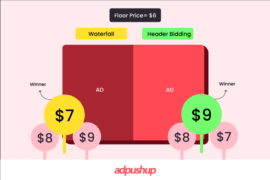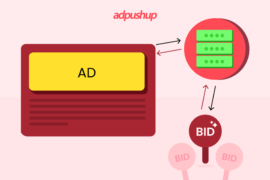Google’s Core Web Vitals scores have put site speed and user experience to the forefront for all publishers. Ask any publisher why their page loads are slow and they will mention ads.
While header bidding still remains an enigma in the ad tech industry, there’s a new kid on the block (Footer Bidding) that promises better user experience and improved website speed.
In this article, we’ll explain footer bidding at length; learn about its pros, cons, implementation, and see how it is different from header bidding.
What is Footer Bidding?
Before we cover footer bidding, let’s take a look at how header bidding works.
To implement header bidding, the wrapper’s code (Javascript) is embedded in the header of the website. In this set up, the framework and auctioning for ads on the page occurs as soon as the page starts to load. This often negatively affects the page speed because ads are competing with other assets of your page (images, videos, text, etc.)
Simply put, header bidding can result in slower page load. Header bidding works from within the user’s browser, page latency increases and the user has to wait longer for the page to load, this is a major dealbreaker for many publishers not willing to sacrifice their user experience.
Enter Footer Bidding. Here, the concept is simple: Don’t support any ad requests until the page has fully loaded.
Footer bidding prioritises the user experience and page loading speed. It allows you to start the auction once the page is loaded completely. Publishers can hold back the ad requests to Google Ad Manager and Prebid until all the web elements such as tracking pixels, images, and content are fully-loaded.
However, the wrapper code in this scenario is still placed in the header of the website. It is called Footer Bidding only because it works in the opposite manner as header bidding.
Also Read:
1. A Simpler Guide to The Header Bidding Technology
2. How to Improve Your Header Bidding Performance?
Pros and Cons of Footer Bidding:
I. Pros of footer bidding:
Footer bidding has some clear advantages over header bidding:
The most important advantage of footer bidding is the improved user experience. Since it lets you load the content of website first, the users are more likely to consume the content, stay engaged, and also view the ads.
Since Google is constantly prioritising page-speed and user experience, implementing footer bidding can also help publishers improve their SEO rankings.
Another advantage of implementing footer bidding is that publishers are no longer limited to a specific number of bidders since the page has already loaded. Hence, despite losing some impressions, they can drive better CPMs by adding more demand partners since the bidding occurs after the page load.
II. Cons of footer bidding:
Admittedly, footer bidding is not for everyone. Here are it’s drawbacks:
1. Late ad loading:
If you implement footer bidding, your ads will load quite late. You can lose revenue if your website content doesn’t load quickly.
2. Not good for sites that have existing loading issues
For sites that haven’t been optimised, footer bidding will impact revenue as your ads won’t load unless the content does. To ensure this doesn’t happen, you’ll need to make sure the site loads at a lightning-fast speed. Footer bidding shouldn’t be implemented on websites that have existed loading issues because it will do more harm than good.
3. Drop in viewability:
If your ads are located on the top of your content or above the fold, Footer bidding is a bad idea. There’s a significant chance you’ll suffer drop in view ability for these ads or placements if your page doesn’t load fast. If you’ve embedded ads in the header section or first page, the user might have scrolled past them already.
4. Requires control of every element of site:
If you’re running a WordPress site or if you have very little control on when different parts of the page can be loaded, then footer bidding is not be right for you. Publishers can only implement footer bidding if they have control of every element of their site.
How to implement Footer Bidding?
In this section, we’ll discuss few steps that you can take to implement footer bidding. We’re assuming you understand some Javascript and already have a header bidding setup on your site.
I. Improve page load speed:
Make sure that your website loads quickly. Go to Page Speed Insights, review your loading speed, and check if there’s any asset that needs improvement.
2. Lazy-load images and embedded content:
To improve speed, we suggest having images lazy-load since they can drastically improve page loading speed. You can use a plugin or the Javascript libraries to lazy-load images.
You can apply the same logic to embedded content as well (YouTube videos and other iFrames). There are a lot of plugins for both WordPress and jQuery. The key is to make sure all your embeds have“data-src” attribute instead of “src” attribute.
3. Defer Scripts & CSS:
To further improve speed, you need to defer the loading of non-essential scripts until the page loads fully. For this, WordPress has many solutions or plugins. You can also defer scripts using the native “defer” HTML attribute or you can defer them via JavaScript.
Also read:
7 Ways to Optimize Your Website for Faster Ad Serving
21 Website Speed Optimization Tools for Publishers to Check Out
II. Improve Ad loading:
Publishers who want to implement footer bidding should ensure that ad loading also happens quickly. Make sure that all the code is loaded when it’s needed. The user’s browser should also be ready to interact with the demand partners.
1. Preload, Prefetch & Preconnect
Best practice is to preload, dns-prefetch and preconnect directives to load critical resources early.
For the HTTP headers, you can send a preload directive to the browser to immediately load core JavaScript functions even before the HTML is downloaded. For HTML header, you can send preload directives for Google Ad Manager. Similarly, preconnect directives in the HTML to preconnect to all our header bidding partners’ RTB endpoints
2. Load timeout:
There could be scenarios where page doesn’t load due to server issue or slow internet connection. May be a specific image or vide simply doesn’t load. And, in this case, the ad auction would never begin, which can result in loss of impressions and revenue.
Hence, a good practice is to put in a timeout of several seconds. That way, the ad auction begins even if the page hasn’t loaded fully.
$(document).ready(function() {
window.adsLoadTimer = setTimeout(function() {
if (!window.prebidAuctionRun) {
window.prebidAuctionRun = true;
runPrebidAuction();
}
},5000);
});
// Normal connection: Run auction when the window.load() event occurs.
$(window).on(‘load’, function () {
if (!window.prebidAuctionRun) {
window.prebidAuctionRun = true;
clearTimeout(window.adsLoadTimer);
runPrebidAuction();
}
});
Conclusion:
Footer Bidding can help publishers remain in line with Google’s push for a better user experience and score better on Core Web Vital metrics. For publishers that have well-optimised sites, moving their stack to run through footer bidding means positive impact on UX and page load time without a hit to the bottom line.
However, keep in mind that it’s not for everyone. Of course, it helps deliver better UX and decent performance. But it is still not widely adopted, at least yet.
Why Choose AdPushup’s Header Bidding Solution?
Time needed: 2 minutes.
AdPushup’s header bidding solution is lightweight and fully automated programmatic advertising solution, integrated with 25+ world class demand partners. Here’s the key highlight and product capabilities:
- Intensified Competition results in higher revenue.
The more buyers available, the higher the chances are of filling all types of available inventory, including both premium and unsold inventory.
- Freedom to bring your own demand
We understand that publishers may have existing partnerships with header bidding demand partners that they may not want to abandon, our bidding engine allows you to onboard them and have them compete with our premium demand sources. Win-win.
- Bid monitoring and discrepancy resolution
AP’s header bidding solution monitors and records all bids made by buyers which can be reviewed by the publisher. In case of any mismatch between recorded bids and final yield, we have a discrepancy resolution process in place.
- Multi-format ads Support
AP’s header bidding engine considers bids for all the ad unit sizes that can fit within the ad container — this creates a wider pool of bids and helps maximise the revenue for every single ad impression.
- Managed header bidding services
While each new header-bidding partner boosts yield, it also introduces more code and complexity, creating a setup that’s messy and lengthy.
AP leverages machine learning and data science to provide managed header bidding services that helps publishers maximize their yield and bring order to the chaos. - Enhance your financial security and stability.
With typical RTB based programmatic setups, publishers are in the dark about big data.
With AP, publishers get access to all the relevant metrics on their accounts, which enhances their financial security and stability. You get extensive documentation and ongoing support to ensure transparency throughout the partnership - Automatic Demand Partner Selection
The number and type of demand partners in an auction can have a big impact on the yield—too many partners can slow the process, too few kill bid competition.
AP’s engine automatically selects the optimal number of partners for each transaction.
Also Read:
1. How to Find the Right Header Bidding Partner?
2. What are Header Bidding Wrappers? How Do They Work?
Frequently Asked Question
Footer Bidding has a simple concept: don’t support any ad requests until the page has fully loaded. It prioritises the user experience and page loading speed. It allows you to start the auction once the page is loaded completely.
Publishers can hold back the ad requests to Google Ad Manager and Prebid until all the web elements such as tracking pixels, images, and content are fully-loaded.
The Javascript (or wrapper code)is placed in the header of the website. It is called Footer Bidding only because it works in the opposite manner as header bidding.

Shubham is a digital marketer with rich experience working in the advertisement technology industry. He has vast experience in the programmatic industry, driving business strategy and scaling functions including but not limited to growth and marketing, Operations, process optimization, and Sales.







